
|
![]()
Greatest Films of the 1930s
1930 | 1931 | 1932 | 1933 | 1934 | 1935 | 1936 | 1937 | 1938 | 1939
Title Screen Film Genre(s), Title, Year, (Country), Length, Director, Description 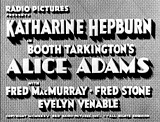



Alice Adams (1935), 99 minutes, D: George Stevens
Director George Stevens' and RKO's social drama was adapted from Booth Tarkington's 1921 novel. A silent version was also released in 1923. In the poignant story, a likeable, small-town teenager Alice Adams (Katharine Hepburn) was from a middle-class background in the midwestern town of South Renford, Indiana, in the early part of the 20th century. The socially-ambitious and poor Alice was frustrated because she desperately wished to be accepted by her upper-class peers, but was embarrassed by her family's social status and lack of money, and her invalid father Mr. Virgil Adams' (Fred Stone) unambitious and crude nature. Although her father was hard-working, he was employed in a lowly job as a clerk in a wholesale drug firm. She was determined to convince her friends that she was from a wealthy family. With her brother Walter (Frank Albertson) as her escort, Alice attended a high-society party-dance, hosted by debutante Mildred Palmer (Evelyn Venable) from a prominent family. During the party, Alice (with wilted flowers and an outdated dress) put on a play-act that she was wealthy and of high social standing. Although the very vulnerable Alice was miserable and out of place, she pretended to be having a good time. Finally, she met wealthy, handsome young Arthur Russell (Fred MacMurray), Mildred's cousin. At the end of the evening, Alice wept bitterly at her rain-spattered bedroom window after returning home from the Palmer dance - feeling completely humiliated by her bedraggled bouquet of flowers, her insensitive escort brother Walter, and dashed hopes of respectability with new-in-town suitor Arthur. The next day, however, she met Arthur again in town and with more affected mannerisms, she told him fanciful tales of her family's fortunes to convince him of her social respectability, and he seemed to show some interest in getting to know her more. He expressed an interest to visit her home, and they walked together to her house. Although she refused his entry into their shabby house, over a few days' time, he courted her on the front porch. Ultimately, the pretentious and aspiring Alice was compelled to invite Arthur into her home, to impress her rich new suitor with a "stylish" dinner party - the film's most memorable scene of the ill-fated "formal" event. Alice's mother Mrs. Adams (Ann Shoemaker) had hired a black maid and cook named Malena (Hattie McDaniel) for the evening - a hot and muggy night. The gum-chewing, slovenly and surly Malena valiantly served a heavy menu, starting with caviar sandwiches and hot soup, and then strong-smelling brussel sprouts and other dishes on serving trays. Everything went wrong during the sweaty, disastrous, tragically-funny dinner table sequence, as it was painfully obvious what her social circumstances really were. Alice suffered with the maid, her socially-awkward father, and the incredibly inappropriate 'formal' dinner menu, and believed afterwards that she would never see Arthur again. (Another added wrinkle during the evening was Arthur's knowledge that Mr. Adams' paternalistic employer J.A. Lamb (Charley Grapewin) had accused Virgil of stealing a glue formula and was planning to open a rival factory to ruin him, and the fact that Walter had embezzled $150 dollars from Lamb's firm. After dinner, Alice interceded and was able to get the two men, Lamb and her father, to work out a harmonious arrangement, to save both him and her brother.) Immediately after dinner, Alice and Russell were forced to retreat to the front porch, where Alice confessed her feelings of failing and her fears that he would be dropping her: ("I feel as if I were only gonna see you about five minutes more all the rest of my life...You're never coming here again. Why it's all over, isn't it? Why it's finished, isn't it? Why, yes...Yes, you must go. There's nothing else for you to do. When anything's spoiled, people can't do anything else but runaway from it. Goodbye"). Arthur was dismissed. Later that evening outside in the film's fairy-tale ending, Arthur was heard asking Alice on the front porch: "A penny for your thoughts." He had remained quietly behind on the porch swing, and even though he knew the whole truth of the Lamb incident and the dinner, and in spite of everything, he professed his love for her ("I love you, Alice") at the end of the evening. She exclaimed: "Gee whiz!" - and they kissed as the film came to a close.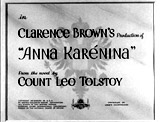


Anna Karenina (1935), 95 minutes, D: Clarence Brown
Russian novelist Leo Tolstoy's 1878 novel of the same name was the basis for director Edmund Golding's silent film Love (1927) (starring Greta Garbo), and also this MGM remake again starring Garbo (it was the most popular, critically-acclaimed version, and more faithful to the original novel). The novel was the subject of many other versions, including the 1948 British film starring Vivien Leigh, a 1985 TV-movie with Jacqueline Bisset, a 1997 US version filmed on location with Sophie Marceau, and recently a UK, Joe Wright-directed 2012 film starring Keira Knightley. The plot was about an ill-fated romance. As the film opened in 19th century Russia, Anna Arkadyevna Karenina (Greta Garbo) was in a loveless, cold and dispassionate 8-year marriage to distinguished Czarist statesman-official Alexei Alexandrovitch Karenin (Basil Rathbone), although she adored her son Sergei (Freddie Bartholomew). While attempting to help her debauched and philandering brother Stiva (Reginald Owen), her paths crossed with nobly-born, young Russian military army officer Count Vronsky (Fredric March) - he stepped out of a cloud of steam on the St. Petersburg station platform of an arriving train when they first saw each other and they became infatuated in love. Their romance was immediately doomed - foreshadowed by the "evil omen" of their witnessing the accidental death of a railroad inspector killed under the wheels of a moving train. When their indiscreet and scandalous liaison threatened Karenin's marriage and position in the Russian society, especially after she made a public request for a divorce (and her privately heartbroken husband refused), the consequences were devastating - and included banishment and humiliation. She decided to give up everything, including deserting her son Sergei, to leave her husband and openly elope and live with Vronsky outside of Russia (where they weren't as identifiable). When Vronsky was recalled to duty back in Russia and had to return to his regiment to fight in the Serbo-Turkish war, Anna became a scorned outcast by society, was cruelly denied access to her son in Karenin's house, and became lonely and miserable. Ultimately, she realized that she and Vronsky were becoming estranged, argumentative, and would never achieve true happiness or peace. She rushed to see him one last time at the Moscow train station as he departed for battle. Feeling entirely despondent and knowing her life was forever doomed, she hypnotically and emotionlessly fell forward and suicidally (?) lost her life under the wheels of a moving train - in a cloud of steam.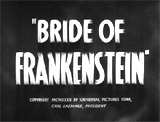


Bride of Frankenstein (1935), 73/90 minutes, D: James Whale
Universal horror director James Whale's masterpiece was a frightening, but campy, classic horror film. As a sequel, it bettered the original film (Frankenstein (1931) - also with Boris Karloff as the Monster), and preceded the next film with an all-star horror cast in The House of Frankenstein (1944). It was remade as The Bride (1985), starring Sting and Jennifer Beals. In the film's prologue set in Lord Byron's (Gavin Gordon) estate on a stormy dark night, original Frankenstein novel-author Mary Shelley (Elsa Lanchester), a 19 year-old bride who was due to marry poet Percy Shelley (Douglas Walton), defended her novel. She argued that it was more than a story about a mad scientist and a monster. During a flashback, the Monster (Boris Karloff) made his first appearance chest-deep in water when he emerged from the dark shadows under a burnt-down windmill - he did not perish in the fiery castle at the end of the first film, but had miraculously survived. As the creature revived, he went on to murder two peasants - Hans (Reginald Barlow), the peasant father of the little girl the Monster earlier accidentally drowned, and his wife (Mary Gordon), before going on a rampage to terrorize the countryside. Meanwhile, the seriously-wounded Dr. Henry Frankenstein (Colin Clive) was restored to health and cared for by his fiancee-bride Elizabeth (Valerie Hobson). The delightfully evil, eccentric, emaciated, but weird and mad alchemist-scientist Dr. Septimus Pretorius (Ernest Thesiger), formally one of Henry's teachers, arrived at Frankenstein's castle. When they traveled to Pretorius' laboratory, he unveiled for Henry the results of his experiments with creating life - several miniature homunculi - six small figures (that he had grown from seeds) in glass jars or bottles. He was able to compel and convince Henry to artificially make a female companion/mate to placate the lonely Monster. At the same time, the Monster peacefully encountered a beautiful young shepherdess (Ann Darling) and saved her from drowning, but then was shot at by a hunter (Robert Adair) in the woods and captured by the villagers, and briefly chained in a dungeon. After his escape, he appeared when hungry to a family of gypsies roasting meat on a campfire spit (and burned his hands in the hot fire). He then wandered into the cabin of a blind Hermit (O.P. Heggie). In this version, the Monster was more human-like, and was even encouraged to speak a few words, enjoy food and music, and a cigar. After leaving when the hut was accidentally set on fire during an encounter with two hunters (John Carradine and Frank Terry), the Monster met with grave robber Pretorius in a crypt/mausoleum, where the crazed doctor promised to make a life-sized "friend" for the Monster, who exclaimed with a smile: "Woman. Friend! Yes, I want Friend like me!" The Monster expressed his self-knowledge about his creation by Henry: "I know. Made me from dead. I love dead. Hate living." As he handled a skull, the Monster repeated Pretorius' promise: "Woman. Friend. Wife." In a classic (and somewhat humorous) scene, a reconstructed Bride (Elsa Lanchester) was reanimated or created ("born") with cracks of lightning bolts (Frankenstein: "She's alive, alive!"). During her ultimate revealing, her eyes opened - seen in a slit in her bandaging. After the unveiling of her face with the unwinding of bandages, she was shown with a wild electrified hairdo and jerky twitching movements. The Monster met his Bride when she let go with a piercing shriek of rejection and revulsion -- and he despaired: ("She hate me, like others"). The Monster decided to spare Henry Frankenstein (and Elizabeth) by permitting them to rush to safety outside, but planned on killing himself, the Bride, and Dr. Pretorius by pulling a level to set off an explosive: ("Yes, go! You live! Go! (To Pretorius) You stay! We belong dead!"). In the finale, explosions rocked the stone-tower and rubble and buried everyone inside alive, while on a hillside closeby, Elizabeth and Henry happily embraced as he offered comforting words to her: "Darling. Darling."


Captain Blood (1935), 119 minutes, D: Michael Curtiz
Director Curtiz' classic adventure film swashbuckler featured Errol Flynn's first starring role, and marked the first of eight romantic pairings with co-star de Havilland. A young 17th century Irish physician/surgeon Dr. Peter Blood (Errol Flynn) was wrongly condemned by a judge for participating in the Monmouth uprising and aiding the rebels by treating their wounds. He was sold into plantation slavery in the Caribbean (Jamaica). He was purchased by the beautiful niece Arabella Bishop (Olivia de Havilland) of a brutal plantation owner, but escaped his unfair sentence and became a leader of a band of fearsome Caribbean pirates. He launched his own battle against Col. Bishop, the colonial governor of Jamaica (Lionel Atwill) in a number of stirring action sequences including sea battles and bombardments and a fencing duel with rival villainous pirate Capt. Levasseur (Basil Rathbone). He also charmingly romanced Arabella.


Dangerous (1935), 78 minutes, D: Alfred E. Green
This film has often been considered the ultimate soap-opera. It was most notable for Bette Davis winning her first Best Actress Academy Award, possibly as a consolation prize because she didn't win for Of Human Bondage (1934) a year earlier. In the melodramatic plot, an idealistic, aspiring, handsome architect Don Bellows (Franchot Tone) attempted to rehabilitate and save an alcoholic former great Broadway star Joyce Heath (Bette Davis) from despair. He sponsored the tempestuous star's comeback in a stage play by bankrolling her efforts. In the process, he lost his heart to her romantically (while breaking off his engagement to his adoring wealthy socialite Gail Armitage (Margaret Lindsay), despite the presence of Joyce's husband Gordon Heath (John Eldredge). When Gordon refused to give his wife Joyce a divorce, she intentionally ran the car into a tree and paralyzed him for life. Joyce was guilt-ridden after the deliberate accident, vowed to take care of Gordon, and sent Don back to Gail.



David Copperfield (1935, UK), 133 minutes, D: George Cukor
Director George Cukor's drama was the definitive Hollywood/UK adaptation of the 1850 Charles Dickens novel - the first and possibly the best of all film versions of Dickens' works. It was the story of young David Copperfield's (Freddie Bartholomew/Frank Lawton) growth to manhood in 19th century England. He lived an idyllic life at first with his recently widowed mother (Elizabeth Allan) and his nurse until his mother married the despicable and mean Mr. Murdstone (Basil Rathbone). When she died while he was away at boarding school, the orphaned David was forced to return home and go to work in his stepfather's sweat-shop warehouse under grim child labor conditions. He ran away to Dover to his eccentric Aunt Betsey (Edna May Oliver) and eventually survived all his trials to become an author, who eventually married his childhood sweetheart Agnes (Madge Evans). With unforgettably colorful secondary characterizations, especially the impoverished but philosophical Micawber (W. C. Fields) and villainous Uriah Heep (Roland Young).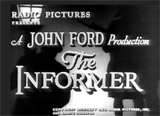

The Informer (1935), 91 minutes, D: John Ford
This was one of John Ford's greatest films in the early part of his directorial career. It was an Academy-Award winner based on the novel by Liam O'Flaherty. This profound expressionistic study of life in 1922 Dublin, Ireland was during the time of the violent Irish Sinn Fein civil rebellion. Gypo Nolan (Best Actor-winning Victor McLaglen), a big, slow-minded, hard-drinking Irish Dubliner, had been ejected from the IRA for refusing to shoot a deserter. Unemployed, he committed the ultimate traitorous act by revealing the identity and betraying his IRA leader and friend Frankie McPhillip (Wallace Ford) in order to collect a twenty pound reward from the hated British Black and Tans - money he hoped would pay for passage to America. Thereby, he began a downward spiral, especially after his friend died in custody. He was regretful, devastated and tormented by his decision and his conscience, drank away his reward money, and was put on trial (where he falsely accused Peter Mulligan (Donald Meek)) and became the object of revenge by the IRA.

Les Misérables (1935), 108 minutes, D: Richard Boleslawski
This was the first (and some consider the best) of the many film adaptations of Victor Hugo's novel of 19th century France, with beautiful cinematography by Gregg Toland. It was not to be confused with the French 1934 version. It told the classic story of good and evil in an unforgiving and unrelenting legal system. Jean Valjean (Fredric March), who had stolen a loaf of bread to survive, was captured and given 10 years of hard labor. He escaped prison and rebuilt his life, becoming a respectable mayor of the town where a truly frightening and vengeful Javert (Charles Laughton) was chief of police. Valjean was identified as a wanted criminal, and then tormented by the unimpassioned, obsessed, and single-minded Javert, who would not let the past be forgotten.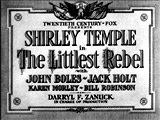


The Littlest Rebel (1935), 70 minutes, D: David Butler
This was one of famous child star Shirley Temple's most well-known 20th Century Fox pictures, although some criticized the film's sequence in which Shirley masqueraded in black face disguise as a "pickinniny," and also commented upon the film's over-idealized view of slavery. Set in the South during the Civil War, young Virginia "Virgie" Houston Cary (Shirley Temple) was the six-year-old daughter of Confederate rebel officer Capt. Herbert Cary (John Boles), who was jailed trying to sneak back through Union lines with her after visiting his sick wife Helen (Karen Morley) in a rundown slave cabin. She saved her father from being executed as a Confederate spy by charming President Abe Lincoln (Frank McGlynn Sr.), sharing an apple with him. Notable for its tap-dancing duet highlight "Polly Wolly Doodle" by Shirley Temple and Uncle Billy (Bill "Bojangles" Robinson).


The Lives of a Bengal Lancer (1935), 109 minutes, D: Henry Hathaway
Director Hathaway's escapist, rousing classic adventure film told a tale of the British Empire at the time of its vast colonial holdings. It followed the adventures of three British soldiers serving in the 41st regiment in an exotic land. Set on India's remote rugged Northwest frontier, the three British Bengal Lancers were: the seasoned and fearless Scottish-Canadian Lt. Alan McGregor (Gary Cooper), gung-ho Lt. John Forsythe (Franchot Tone), and the naive, raw, untested recruit Lt. Donald Stone (Richard Cromwell) - the bitter son of a stern, high-ranking commanding official Col. Tom Stone (Guy Standing). The two soldiers attempted to rescue Stone after he was captured by warring chieftain Mohammed Khan (Douglas Dumbrille), and were captured and tortured themselves. It culminated in an exciting conclusion and battle - in which the trio of British soldiers found themselves fighting from inside the enemy's mountain fortress, as the Lancers attacked and laid siege. In the end, Lt. Stone redeemed himself by killing Khan, although McGregor died during the fierce assault.


A Midsummer Night's Dream (1935), 132 minutes, D: Max Reinhardt, William Dieterle
This fanciful Warner Bros.' version of William Shakespeare's play, co-directed by William Dieterle and Max Reinhardt, featured lavish sets, costumes, choreography, and a tremendous all-star cast. Unforgettable performances were by James Cagney cast as Bottom and 15 year-old Mickey Rooney as Puck, and Olivia de Havilland performed in her film debut as Hermia. It was the first major Hollywood attempt at a Shakespearean play, and won two Oscars - Film Editing and Best Cinematography by replacement film-maker Hal Mohr (a write-in nominee/candidate). It was also the sole sound feature film of German experimental theater director Max Reinhardt (who had directed the stage production in Germany and in 1934 staged the spectacular play at the Hollywood Bowl - leading to the film's contract for a big-screen version). Classical composer Mendelssohn's music was adapted by Erich Wolfgang Korngold. The lengthy text of Shakespeare's play was considerably cut back, in its story of mythical and mischievous forest creatures (fairies and artisans) who planned to put on a play for the amusement of the royal court at a royal wedding. In the film's opening, beautiful, shimmering fairies appeared in the forest mist, ran through the woods with ballet-like moves, and ascended into the moonlit sky. The central event in the film surrounded the festivities of the wedding of Theseus, the Duke of Athens (Ian Hunter) to Queen of the Amazons Hippolyta (Verree Teasdale). Tradesmen were rehearsing a ludicrous dramatic play titled Pyramus and Thisbe (a film-within-a-film) to be presented at the wedding celebration. Instead, the tale became one of a battle between King Oberon (Victor Jory) and disobedient Queen Titania (Anita Louise) of the Fairies. During the escapades, Oberon applied a love-potion from a flower onto the eyelids of a sleeping Titania - hoping that she would fall in love with the first creature to see her upon awakening. Her eyes happened to fall on Nick Bottom (James Cagney), one of the amateur dramatists (playing the role of Pyramus), who had been turned into a donkey. There were further misadventures of two couples (four young lovers) who were also confused and bedazzled by meddlesome interventions. The two young men in couples, Lysander (Dick Powell) and Demetrius (Ross Alexander) both loved Hermia (Olivia de Havilland), but a fairy potion from Oberon's mischievous young page or elf Puck (Mickey Rooney) changed Lysander's love toward Helena (Jane Muir) who was actually in love with Demetrius. When the sleeping Lysander was awakened by Helena, he immediately fell in love with her. Puck was reprimanded by Oberon for mistaking Lysander for Demetrius, and applying the 'love-juice' to the eyes of Lysander instead of Demetrius. Later, the intervening fairies changed Lysander's love back to Hermia, so that both couples would be with their true love - to marry on the same day as the Duke's wedding to Hippolyta; the happy couples who wed were Lysander with Hermia, and Demetrius with Helena. In the film's ending, the final line, spoken in a farewell soliloquy or epilogue by Puck (at the Duke's bedroom door) suggested that everything seen before was a 'slumber'd' dream, after which he bowed and the word "Finis" appeared: ("If we shadows have offended, think but this and all is mended. That you have but slumber'd here while these visions did appear. And this weak and idle theme, no more yielding but to dream. Gentles, do not reprehend, if you pardon, we will mend. Else the Puck, a liar call, so good night unto you all. Give me your hands, if we be friends and Robin shall restore amends!").



Mutiny on the Bounty (1935), 133 minutes, D: Frank Lloyd
Director Frank Lloyd's classic marine adventure and Best Picture-winning film (and the top box-office film of the year) was based upon Nordhoff and Hall's 1932 account of the hardships aboard an 18th century British man-of-war, the H.M.S. Bounty, on a naval sea expedition launched in 1787 to the remote South Pacific in search of breadfruit. It was the first (and best) of the filmic versions of the familiar tale, that was two years in the making and over-budget. It opened with the title card prologue: "In December, 1787, H.M.S. Bounty lay in Portsmouth harbour on the eve of departure for Tahiti in the uncharted waters of the Great South Sea. The Bounty's mission was to procure breadfruit trees for transplanting to the West Indies as cheap food for slaves. Neither ship nor breadfruit reached the West Indies. Mutiny prevented it - mutiny against the abuse of harsh eighteenth century sea law. But this mutiny, famous in history and legend, helped bring about a new discipline, based upon mutual respect between officers and men, by which Britain's sea power is maintained as security for all who pass upon the seas." The idealistic midshipman Roger Byam (Best Actor-nominated Franchot Tone), on his first cruise as a midshipman, gave a toast before a two-year voyage of the Bounty to the South Pacific: "To the voyage of the Bounty. Still waters of the great golden sea. Flying fish like streaks of silver, and mermaids that sing in the night. The Southern Cross and all the stars on the other side of the world." Heartless, brutal, sneering, arrogant and sadistic Captain Bligh (Best Actor-nominated Charles Laughton), commander of the H.M.S. Bounty who was obsessed with discipline, subjected the crew to cruel suffering and degradation during his tyrannical abuse of power. Early on, he demonstrated his ruthless power by ordering the flogging of a dead man, to punish an infraction to the letter of the law. Later, he told his second in command, lieutenant Fletcher Christian (Best Actor-nominated Clark Gable), about how he ruled over his seamen: "They respect but one law - the law of fear...I expect you to carry out whatever orders I give, whenever I give them." Bligh continually goaded Fletcher Christian who had already gained the respect of the entire crew. The voyage was long and arduous, but the Bounty finally arrived in Tahiti. Christian was ordered to stay on deck, but Byam was allowed to go ashore, where he was befriended by Hitihiti, the island's chieftain. Byam was quickly entranced after meeting and falling in love with one of the beautiful Tahitian women, Tehani (Maria "Movita" Castaneda, who later married Marlon Brando!). When the chief arranged for Christian to come ashore for one day, the Master's mate also met and fell in love with Hitihiti's granddaughter, Maimiti (Mamo Clark). After six months of relief on the idyllic island of Tahiti, where most of the men married Tahitian natives, they reluctantly left after securing their breadfruit trees. It didn't take long for Bligh's viciousness to be displayed again. The incident that triggered the famous mutiny on board was Bligh's insistence that the sick, elderly ship's Dr. Bacchus (Dudley Digges) struggle to come topside to witness the flogging of five crew members caught attempting to desert the ship and return to Tahiti. When the deathly-ill, alcoholic doctor died, Fletcher's restraint broke. The provoked, heroic, fair-minded first officer Fletcher Christian led part of the crew into a mutiny, and set Bligh adrift on the high seas on a small boat. Christian spoke: "I'll take my chance against the law. You'll take yours against the sea." Amazingly, with only limited supplies and a few nautical instruments, Bligh was able to navigate the boat on a 49 day, 3,618 mile voyage to Timor in the Dutch East Indies. Meanwhile, the mutineers returned on The Bounty to the island of Tahiti where they lived happily for many months. Christian married Maimiti and Byam married Tehani. When the vengeful Bligh returned a year later, on the British frigate - H.M.S. Pandora, Fletcher Christian made a hasty retreat from the island to nearby uninhabited Pitcairn Island. He deliberately crashed the Bounty into the rocks and set it on fire. Eventually, the remaining sailors on Tahiti (Byam and others) were returned to England where they stood trial. In the film's version of events, the men were pardoned (from a sentence of hanging) after a passionate speech from Byam about all the cruelties and inhumane injustices imposed by Bligh on the men.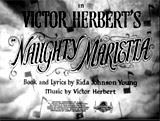

Naughty Marietta (1935), 106 minutes, D: W.S. Van Dyke II
This musical marked the very first film teaming of the famous romantic and singing duo Nelson Eddy and Jeanette MacDonald - it became a major box-office hit at the time. Based upon Victor Herbert's 1910 operetta, it was set in 18th century France. An orphaned French Princess Marie de Namours de la Bonfain ("Marietta Franini") (Jeanette MacDonald), refusing an arranged marriage to Don Carlos, a Spanish man she didn't love, escaped to colonial America (New Orleans, Louisiana) by exchanging destinies with her maid. When pirates attacked the ship bound for America, she was rescued and fell in love with Indian scout Capt. Richard Warrington (Nelson Eddy). Although he left her when she played hard-to-get, he returned to locate his true love and took her with him into the frontier. With songs including "The Italian Street Song," "Tramp, Tramp, Tramp," "I'm Falling in Love," and "Ah, Sweet Mystery of Life."

A Night at the Opera (1935), 92 minutes, D: Sam Wood
This comedy was the first of five Marx Brothers films at MGM - it was a polished Marx Brothers classic (their first film without Zeppo), one of their biggest hits, with famous routines and non-stop one-liners. Groucho played crafty promoter Otis B. Driftwood who wooed millionaire dowager Mrs. Claypool (perennial Margaret Dumont) and conned her into supporting an opera company with an investment of $200,000, so she could become a high-society member. With Fiorello (Chico) and Tomasso (Harpo), they all but destroyed and then eventually saved an operatic production. Memorable scenes included the crowded stateroom scene and the climax during the opening night performance of the grand opera.


Peter Ibbetson (1935), 88 minutes, D: Henry Hathaway
Based on the 1891 published novel by George du Maurier, this romantic drama was the story of a surreal, metaphysical, and transcendent romance between two who were separated as children and reunited by destiny years later - and also spiritually after death. The two were: Parisian architect Peter Ibbetson (Gary Cooper), commissioned to design stables on the property of British Duke of Towers (John Halliday), and the Duke's lovely wife Duchess Mary of Towers (Ann Harding). During his work, Ibbetson recognized Mary as his long-lost childhood friend named Mimsey that he had played with in the same garden, when his name was Gogo. The Duke's jealousy led to the accidental death of the Duke during a struggle with Ibbetson, and he was unjustly sentenced to life in prison (although it was self-defense). Incarcerated, he had many surreal visions and dreams of his lover Mary - and a promise of eternal happiness with her - fulfilled with her after they both died and had a final rendezvous together.


Ruggles of Red Gap (1935), 76 minutes, D: Leo McCarey
Director Leo McCarey's western comedy (with a sole Best Picture nomination) was one of the best (and funniest) screen comedies ever made. It told about a clash of cultures and classes, and also functioned as a fish-out-of-water tale and comedy of errors. Its plot opened in 1908 as upper class British Lord George Van Bassingwell, an English nobleman known as the Earl of Burnstead (Roland Young), lost his very proper and stuffy yet extremely efficient manservant-valet butler Marmaduke Ruggles (Charles Laughton) during a high-stakes poker game to a wealthy, visiting American ranching couple: society-conscious wife Effie (Mary Boland) and unrefined, millionaire lumber and rancher-cattle baron Egbert (aka "Sourdough") Floud (Charles Ruggles). Ruggles stoically accepted the sudden news, although was worried about entering the "untamed" USA: "America, my lord, a country of slavery." Ruggles accompanied his unmannered, uncouth nouveau riche employers from Paris back to their home in the Wild Western town of Red Gap, Washington. Upon his arrival, Ruggles met Effie's snobby, aristocratic and priggish brother-in-law Charles Belknap-Jackson (Lucien Littlefield) and his wife (Leota Lorraine) (Effie's sister), and Egbert's saucy, down-to-earth, cigarette-smoking mother-in-law "Ma" Pettingill (Maude Eburne). All of the Floud family members lived in a huge mansion. Egbert, who continued to treat Ruggles as an equal, introduced Ruggles as "Colonel" to everyone in this land of opportunity. The title was soon misinterpreted by a newspaper reporter as Ruggles' designation as a retired British Army colonel with a high social and military status. Therefore, he was mistakenly identified as an important society figure in a turn-of-the-century frontier town, and was able to avoid being fired and sent back home. He was quickly smitten by widowed Mrs. Prunella Judson (Zasu Pitts), a skilled culinary artist whom he romanced. The stiff, upper-lipped Ruggles had trouble, at first, adjusting to the informal, rowdy frontier town, but ultimately, he was able to break his indentured bonds of servitude and free himself from class restrictions. Ruggles complained that he no longer wished to be a servant - he was convinced that he could fulfill his own dream to be free and become a self-made man. The film's highpoint occurred in the town's Western barroom, the Silver Dollar Saloon, where the drunken Ruggles recited Lincoln's Gettysburg Address after Egbert faltered and couldn't remember the words. Claiming that he was inspired by "what Lincoln said at Gettysburg," Ruggles seriously and masterfully recited from memory the entire Address to the audience - first softly and then reaching a higher volume as more dumb-founded, undignified but subdued cowhands, bar-drinkers and patrons moved closer and listened in (with multiple cutaway shots). Afterwards, with encouragement from Mrs. Judson and others, it was suggested that Ruggles - to stand on his own two feet - open a new restaurant in town. The name Anglo-American Grille was finally decided upon. Ruggles would be freed and liberated from his job duties to become an entrepreneur and attain the American democratic dream of self-determination. But then, due to an impending visit by Lord Burnstead, Ruggles feared that the Earl would be reclaiming him and taking him back to England to resume his hereditary life of servitude, and he was ready to give up his restaurant dream - although Mrs. Judson vehemently objected. During a dinner party held in the Earl's honor, Ruggles reappeared and declared his 'independence' from the Earl because of his new status as a free man, and he firmly announced that he wouldn't return to London, because he was entering a trade (opening a restaurant). On opening night at the Grille during a celebration, Ruggles found himself defending his former master from class-based insults from the nasty Belknap-Jackson, after the Earl announced he had just become engaged to the town's beautiful barkeeper and dance-hall girl Nell Kenner (Leila Hyams). Ruggles grabbed Belknap-Jackson by the neck and threw him out, but then feared he had overstepped his bounds and ruined his business. To Ruggles' surprise, the Earl delivered a speech to praise Ruggles. He was summoned from the kitchen and brought into the dining room, where the entire crowd sang "He's a Jolly Good Fellow." Egbert suddenly realized that the song was for him!: "Why, you old plate of soup, they're singing it for you!" Ruggles was thankful and jubilant: "My friends, God Bless You All!"


The Scoundrel (1935), 76 minutes, D: Ben Hecht, Charles MacArthur
This film won the Oscar for Best Writing, Original Story (by directors Hecht and MacArthur) for its witty script and great lines of dialogue, and its theme of redemption. Both Hecht and MacArthur had cameos as bums in the flophouse scene. The film also marked the film debut of Burgess Meredith as a minor uncredited character. The American League of Decency banned the film. In the plot, a manipulative, unpleasant and ruthless New York publisher/writer Anthony Mallare (Noel Coward in his first starring film role) survived by using everyone he came into contact with. He destroyed the career and life of aspiring young author Paul Decker (Stanley Ridges) who soon lost his career and self-respect. As a cold-hearted, love 'em and leave 'em womanizer, he loved naive young poetess Cora Moore (Julie Haydon), Decker's fiancee and then abandoned her after 6 months for a new lover, a concert pianist. Cora cursed him - hoping his plane crashed and that he might die, and thinking that no tear would be shed for him. When he actually perished on a Bermuda-bound airplane flight, his ghostly spirit was allowed to return to the world for one month to wander the Earth to atone for his actions, to see if he could find anyone who mourned his passing.

A Tale of Two Cities (1935), 120 minutes, D: Jack Conway (and Jacques Tourneur for second-unit sequences)
This lavish MGM film adaptation of Charles Dickens' monumental classic novel of the French Revolution was a blockbuster film for David O Selznick. It was filmed twice in the silent era, in 1911 and 1922, and also in the sound era in 1958 and 1980. Dissolute Sydney Carton (Ronald Colman), an aimless and carefree London lawyer, found his purpose in aiding beleaguered and downtrodden victims of the Reign of Terror after the French Revolution. He heroically sacrificed his own life to save another man Charles Darnay (Donald Woods) from the guillotine and for the love of the woman Lucie Manette/Darnay (Elizabeth Allan) that they both loved. Carton delivered haunting and famous last words before his execution: "It's a far, far better thing I do than I have ever done. It's a far, far better rest I go to than I have ever known."



The 39 Steps (1935, UK), 87 minutes, D: Alfred Hitchcock
One of the all-time great thrillers, this was Hitchcock's first great masterpiece. In London, a visiting/vacationing Canadian rancher Richard Hannay (Robert Donat) attended a Palladium vaudeville act. When a shot rang out, he ended up in the company of a frightened woman, a female British agent Miss Annabella Smith (Lucie Mannheim). He was given a map of Scotland and told about an international spy ring (with vital national security secrets) run by a man missing part of one finger. Sheltering her for the night, she was murdered, and he found himself as an innocent man who must avoid police authorities (who suspected him of the murder) and pursuit by spies (who wanted to silence him). He took on her mission, and following the only clues he had, ended up in Scotland. On the way, he was handcuffed by the spies to a strange woman Pamela (Madeleine Carroll), who at first hated him believing he was a criminal, but ended up in love with him and helped him solve the case.




Top Hat (1935), 101 minutes, D: Mark Sandrich
From RKO Studios, this was the fourth film teaming the dancing pair Astaire/Rogers, possibly their best (and most successful) work, with choreography by Hermes Pan and Astaire, beautiful Art Deco sets, and integrated music from Irving Berlin. Memorable Irving Berlin songs/dances included: "Isn't This a Lovely Day (To Be Caught in the Rain)," "Top Hat, White Tie and Tails," "Piccolino," and "Cheek to Cheek." American dancer Jerry Travers (Fred Astaire) pursued the romantic love of his life Dale Tremont (Ginger Rogers) from London, England to Venice, Italy. In London, he first met her in the hotel when his loud tap-dancing awakened her in the room below. In a complicated and comical case of mistaken identity, she thought he was married to her best long-suffering friend Madge Hardwick (Helen Broderick). Despite Dale's marriage to a rival Italian fashion designer Alberto Beddini (Erik Rhodes), in anger, Astaire and Rogers were reconciled and reunited in a gondola by film's end.


Triumph of the Will (1935, Germ.) (aka Triumph Des Willens), 114 minutes, D: Leni Riefenstahl
Nazi Fuhrer leader Adolf Hitler commissioned dancer/actress-turned filmmaker Leni Riefenstahl to make this notorious documentary to record and celebrate the sixth Nazi Reich Party Congress held in September 1934 in Nuremberg. This spectacular propagandistic film glorified and praised the might of the unjust and evil Nazi regime and state with masterful images, rapid cuts, a Wagnerian score, and ingenious camera angles and compositions. This infamous, extravagant two-hour film is still considered the most powerful propaganda film ever made, with grandiose opening shots of Messianic Hitler's arrival by plane, his heroic entrance and adulation by saluting ("Sieg Heil") multitudes and uniformed party members and soldiers (and Hitler Youth), and his charismatic exalted character during rousing speeches.